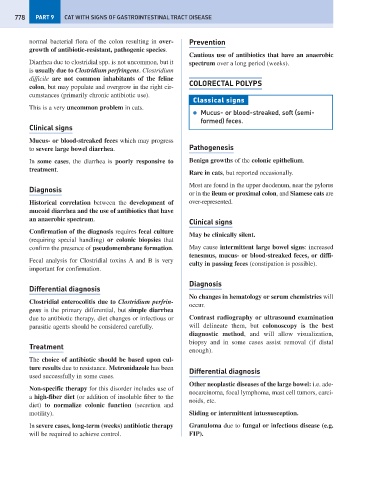Page 786 - Problem-Based Feline Medicine
P. 786
778 PART 9 CAT WITH SIGNS OF GASTROINTESTINAL TRACT DISEASE
normal bacterial flora of the colon resulting in over- Prevention
growth of antibiotic-resistant, pathogenic species.
Cautious use of antibiotics that have an anaerobic
Diarrhea due to clostridial spp. is not uncommon, but it spectrum over a long period (weeks).
is usually due to Clostridium perfringens. Clostridium
difficile are not common inhabitants of the feline
COLORECTAL POLYPS
colon, but may populate and overgrow in the right cir-
cumstances (primarily chronic antibiotic use).
Classical signs
This is a very uncommon problem in cats.
● Mucus- or blood-streaked, soft (semi-
formed) feces.
Clinical signs
Mucus- or blood-streaked feces which may progress
to severe large bowel diarrhea. Pathogenesis
In some cases, the diarrhea is poorly responsive to Benign growths of the colonic epithelium.
treatment.
Rare in cats, but reported occasionally.
Most are found in the upper duodenum, near the pylorus
Diagnosis
or in the ileum or proximal colon, and Siamese cats are
Historical correlation between the development of over-represented.
mucoid diarrhea and the use of antibiotics that have
an anaerobic spectrum.
Clinical signs
Confirmation of the diagnosis requires fecal culture
May be clinically silent.
(requiring special handling) or colonic biopsies that
confirm the presence of pseudomembrane formation. May cause intermittent large bowel signs: increased
tenesmus, mucus- or blood-streaked feces, or diffi-
Fecal analysis for Clostridial toxins A and B is very
culty in passing feces (constipation is possible).
important for confirmation.
Diagnosis
Differential diagnosis
No changes in hematology or serum chemistries will
Clostridial enterocolitis due to Clostridium perfrin-
occur.
gens is the primary differential, but simple diarrhea
due to antibiotic therapy, diet changes or infectious or Contrast radiography or ultrasound examination
parasitic agents should be considered carefully. will delineate them, but colonoscopy is the best
diagnostic method, and will allow visualization,
biopsy and in some cases assist removal (if distal
Treatment
enough).
The choice of antibiotic should be based upon cul-
ture results due to resistance. Metronidazole has been
Differential diagnosis
used successfully in some cases.
Other neoplastic diseases of the large bowel: i.e. ade-
Non-specific therapy for this disorder includes use of
nocarcinoma, focal lymphoma, mast cell tumors, carci-
a high-fiber diet (or addition of insoluble fiber to the
noids, etc.
diet) to normalize colonic function (secretion and
motility). Sliding or intermittent intussusception.
In severe cases, long-term (weeks) antibiotic therapy Granuloma due to fungal or infectious disease (e.g.
will be required to achieve control. FIP).

